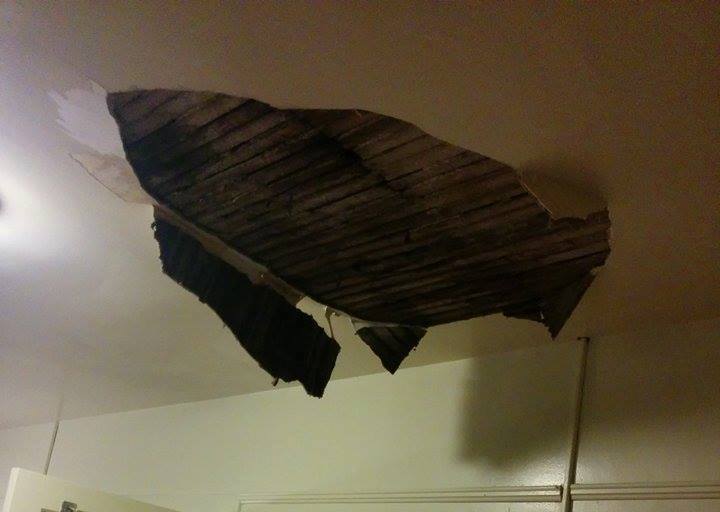By: Teri Bradford
One of the major selling points of Chatham University is the historic campus. Students walk among an arboretum, have first and only edition books in the library, and regularly pass buildings that hold the names of Pittsburgh legacies. Most excitingly, students who live on campus stay in mansions, some of which have been standing since before 1869 when Chatham was first the Pennsylvania Female College.
However, as the years pass, the historical landmarks students live in have been seeing problems. When students have construction issues in the residence hall living areas, they are encouraged to put in work orders to get the problem fixed. From flickering lights to broken windows, students are told that maintenance will get it done and preserve the history.
Robert DuBray, the director of facility management for the Chatham campuses, explained what happens when a student puts in a work order.
“The work order goes to the [Resident Assistant] or the [Graduate Resident Assistant] and it’s sent over to Lisa, [the secretary at Rea Garage], who puts it into the computer,” said DuBray. “Then she issues it to the appropriate tradesperson to make the correction. They will go to the location within the next day or two. [The tradesperson] will assess what the problem is and whether or not they have to order parts or if it’s a quick fix. Then they have these small red cards that they are supposed to fill out briefly just to tell the occupant that they were there and are ordering parts, that they fixed the problem, or whatever the case may be just so they can close the loop with that person.”
However, some students are finding that their work orders have graduated from leaky faucets to plaster and debris falling from their ceilings. Diana Cabrera, a junior, found herself in a serious dilemma early in the fall semester.
“I noticed my bed had tiny spots of wetness, then realized the ceiling above my bed was dripping water,” said Cabrera. “When I initially moved in, no one warned me about the ceiling. A friend who lived next to this room in previous years said that the area around the door had water damage, [but] the area above my bed was nowhere near the door’s water damage. I ended up leaving a towel on my bed to soak up the water since I was going to be out late for [a theater] rehearsal.”
Cabrera said she did not put in a work order because she didn’t have the time and didn’t think a small leak was a relevant problem. She found that she was mistaken later that night.
“I came back to my room shortly after midnight. The desk attendant just got off, and she was my roommate. She told me there was something wrong with my side of the room. We both went up to the room and saw my bed was completely drenched, [and] so was the floor on my half of the room, including under my bed where I stored items.”
Cabrera said that Residence Life moved her to the Gate House for the night and eventually relocated her and her roommate.
“I would go to the room regularly while it was being repaired because I did not fully move out. My stay in Fickes was intended to be temporary. When I went to my Rea room, I would clean up the plaster [and] move furniture around, so it wasn’t in the way or in danger of having more things fall on it. I had to throw out items that were damaged by the water or had started to grow mold. I would open the window while I was there and turn on my fan to circulate the air because it was difficult to breathe and smelled terrible. The repairs took longer than a week. I was able to move back the Tuesday before classes started again after Fall break,” said Cabrera.
She praised the Residence Life staff life for relocating her so quickly but said that the RAs weren’t informed when she relocated or returned. Though she no longer lives in the room, to Cabrera’s knowledge, the roof is fixed.
Incidents like these happen in upper campus housing, but also in lower campus housing. Earlier this semester, a bathroom ceiling in the Chatham undergraduate apartments collapsed, leaving a leaky hole in sophomore Lacey Massari and her roommates’ bathroom.
“[The damage] happened on a Tuesday night,” said Massari. “[My roommates and I] called the emergency number, and they said that someone would come the next morning, but no one did. Someone eventually came and said the plumber would come on Thursday, but they didn’t.”
Massari said that a plumber came on Friday but, that the leaking came from the room above, stopping it from being a quick fix. Corrin Walker, a junior transfer and a member of the track team, is the resident in the bathroom above Massari’s.
“My roommate and I’s shower was leaking to the apartment below us and [maintenance] came on a Tuesday to fix the problem,” said Walker. “The maintenance man came and said that he fixed it, and I just needed to give it an hour to let the caulking dry. I had class all evening and didn’t come back until later. When I tried to turn on the water, nothing came out. So I called [the maintenance number], and a woman said that there would be someone there the next morning. They came later that evening, and the maintenance man left a note saying ‘debris stuck in shower body need to replace whole unit will order new one sorry.’
Walker says she didn’t call again because she knew that they were ordering a unit, and that may take time. However, when it came to be Monday, she felt she needed to take action.
“That is when I talked to Kim Small [in Residence Life], and she said that she would help me and send in another work order. On [the next] Tuesday it still wasn’t fixed. When I told my coach I still didn’t have [a shower]; he contacted Heather Black. I explained my situation to her, and she said she would talk with facilities to get the problem fixed. Finally, on Thursday, my shower was fixed. When it was all said and done, it was 11 days that we went without a shower,” said Walker.
Since then, Walker says that her shower is working, and Massari says the leaking has stopped in her bathroom, but the hole has not been patched up.
Cabrera’s, Massari’s, and Walker’s stories are not uncommon among the campus. There have been discussions amongst the student body about horror stories in different campus buildings.
As the director of facilities, public safety, and transportation, DuBray says that he receives many complaints from students as well as parents, faculty, and staff. He encourages the community to look at the bigger picture.
“I’m responsible for every building on this campus, and we don’t have that many collapses [within residence halls],” said DuBray. “What we do here is big but with [the] support of the senior administration, we try to maintain every single building [with] the intent that it was meant to be. Every building has got something [that needs work]. That’s all controlled by a capital budget that we try to fit in during the summer months when we can, hopefully, do [construction] uninterrupted. We have a window of opportunity [in the summer] to do this work, so it’s a challenge.”
The facilities team at Chatham takes care of the daily work orders in residence halls, offices, academic buildings on the Shadyside, Eastside, and Eden Hall campuses. In the summers, the team does the bigger renovations including the newly transformed carriage house and post office. And in the winter, the team clears the pathways, stairs, and roads for Chatham and the Woodland neighboring community.
“We get over 25,000 requests for service [in a year], and we only have a handful of tradespeople,” said DuBray. “We have two plumbers, two electricians, one HVC cooling guy, two painters, [and] two carpenters. We do a pretty good job of responding and getting things fixed.”
As for the campus horrors, DuBray asks the community to be wary of stories that may be lacking truth. Many students may be concerned about things in their dorms such as cracks in the plaster of their dorms, which are more benign than anything.
“[With] all due respect to the students or whoever makes the comments, they need to know what the problem is before they elaborate or blow it up into something that it’s not. As soon as you find something, and we can’t stress it enough, tell all the RAs and GRDs as soon as a problem is identified in your building. We need to be notified because we need to investigate to see what the extent of the problem is. Then, if at all possible, we fix it right away. But if it’s [in] the dead of winter, it’s a little tough to get [to] the roof of a building for a leak, but we still do it. So let’s not lose track of really what it is,” said DuBray.
“Some [students] complain, and it’s legitimate, some exaggerate. [We] treat certain circumstances that arise, but we don’t know it’s a problem until someone reports it. We don’t just ignore things that are leaking,” he continued. “We don’t put students at risk in an area that shouldn’t be lived in. We would never do that. It takes a lot to maintain these buildings at the level of activity that they get, and we operate about 12 months a year. We don’t get any downtime, but I’ll say it again; when we get a problem we address it. Some are corrected immediately, some take longer, it’s just the nature of the beast.”
DuBray says that many complaints come from students possibly thinking that their problems are worse than they are.
“I deal with students. I deal with parents because they get reports from their son or their daughter that the sky is falling, and the sky is not falling. It’s a crack above your bed that you stare at every night. It’s a roof. It’s just a hundred-year-old building.” said DuBray.
Some members of the Chatham community want to see more action in the way maintenance handles the campus and won’t settle for less. The topic of building conditions has risen in Chatham Student Government meetings multiple times in the 2015-2016 school year alone. Early in the fall semester, Bethany Bookout, President of the Class of 2018, spoke on the issue.
“When will we stop band-aiding problems in the residence halls?” Bookout asked.
The idea that Chatham has lower quality living conditions that can be fixed is something that is not new to the campus. On Niche, a website designed for providing reviews, anonymous or not, and insight on colleges shows Chatham students expressing frustrations about their living conditions up to five years ago.
“They won’t update the dorms because they would have to comply with codes for historical buildings. So they leave them. I have seen the paneling on the ceiling fall off, [and] someone’s windows [almost] fall out all winter (later to just have plexiglass screwed in). The bathrooms are never quite clean and have improper ventilation. There is mold and scum [almost] everywhere,” said an anonymous junior student’s comment from 2011.
Two years later, a similar comment was written by a Chatham alum.
“Buildings were falling apart, [leaking], balconies on buildings were physically separating from buildings. [Roofs] had green vegetation growing on [them], as it was so old it needed to be replaced, and [the roofs] leaked,” read a comment from an alumnus in 2013.
“These are old buildings and they are in deep need of repair,” 2011 sophomore student stated simply.
DuBray acknowledges the fact that these buildings are older, and that there are unique difficulties that come with this. However, he wants it to be known that the facilities team is doing the best they can.
“You have to think about how many buildings we have, how many rooms we have. We have not had a problem in these dorms. These are old buildings, I give you that much, and we do get the occasional roofing [problem]. We try to address that as much as possible. We put new roofs on Woodland. We put new roofs on Fickes. We’ve repaired roofs over here in Rea and Laughlin,” said DuBray. “You can’t just go in and fix them any way you want to. You have to maintain the integrity of the building and its historical appearance. In some of these [buildings], like Mellon, [the walls] are 38 inches thick. If you have a plumbing or electrical problem, sometimes you just have to abandon it because you can’t get to the problem and then rewire or re-plumb.”
The effects of time can be seen in Mellon, but also in some of the academic buildings. The prayer room in the basement of Braun Hall sees some need for repairs as well.
“I have absolutely no idea what is going on with the hole in the wall in the Prayer Room,” said Maryem Aslam, a Muslim commuter student who uses the prayer room while on campus.
Muslims pray five times a day, so Chatham’s community uses it often.
“The hole has been in the wall of the Prayer and Meditation room for at least the duration of the Fall 2015 semester,” said Aslam. “Before it was a hole, it seemed as though the wallpaper or paint was bubbling due to the humidity or atmosphere of the basement of Braun Hall. The hole was covered up by plaster for a [few months], but it was never properly repaired. [Assistant Dean of Students] Mary Utter, said that she would email the head of facilities and let me know when s/he replied. I have not heard anything since I went to the Office of Student Affairs last week.”
Aslam says she has been off campus for the past week and is not sure if it has any progress.
“Older buildings present a lot of problems. It’s all old piping,” said DuBray. “We try to maintain safe, secure buildings, but it’s a structure. Things are going to go wrong; it’s what happens with old buildings. It’s the difference between a young person and an older person. They’re going to require more medical help as the years go on. It’s a never-ending battle for us. But that’s kind of the mystique and the character of the campus.”
Destynie Chase, a sophomore student who lives in the apartments, considers the idea that facilities may not be the problem.
“I’ve heard if you email maintenance directly instead of going through Chatham [with work orders]; things get fixed in a timely matter,” said Chase. “Maybe the solution is to cut out the middleman.”
Though for Walker, she did cut out the middleman in her situation and directly called maintenance. She found that this did not hurry the results.
“I understand that sometimes it takes time to fix issues, but I thought I was being courteous by giving them time to order the new unit,” she said. “I really appreciate my coach, Kim, and Heather for putting in the time to help me fix the problem, but I feel like it still should have been done in a more timely manor. I’m not sure where the miscommunication was with the issue, but I wish there [were] a way I could have communicated better with maintenance so that the process could have been fixed quicker.”
Changes may need to be made on the campus to satisfy all parties involved. Proper upkeep is essential for the historical buildings that create the school many students have come to love. Until then, DuBray encourages students to come to him if they have concerns.
“Anytime when anyone has a concern, I’m more than available,” said DuBray.










